Dancing Physics For Ms. Rebecca
lvwarren at wdv dot com
Demonstration of a Principle:
Standing Waves On Strings, SWIS for short.
Standing
Waves are the Basis of All Stringed and Wind Instruments
Demonstration:
|
y = sin(x)
|
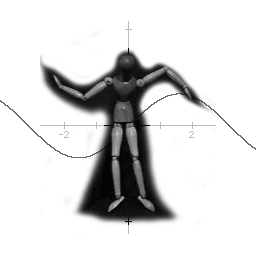
|
|
pronounced "sign"
|
|
|
y = cos(x)
|
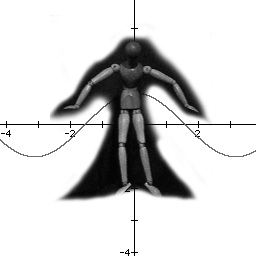 |
|
pronounced "co-sign"
|
|
|
lo frequency = lo pitch
|
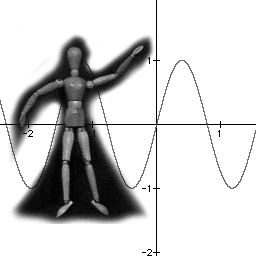
|
|
cello, thunder, train
|
|
|
hi frequency = hi pitch
|
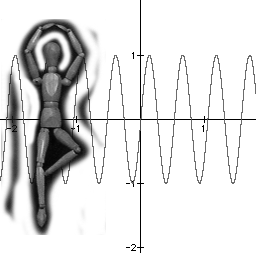
|
|
violin, rain, beeper
|
|
|
hi amplitude = loud
|
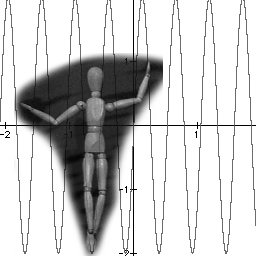
|
|
loud music takes more power
|
|
|
lo amplitude = soft
|
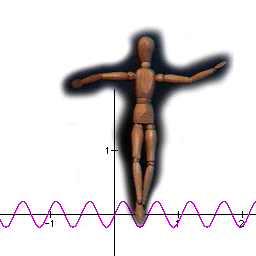
|
|
soft music takes less power
|
|
|
node = no motion
|
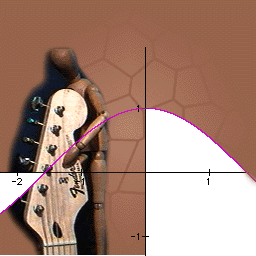
|
|
the hand is the node
|
|
|
antinode = go motion
|
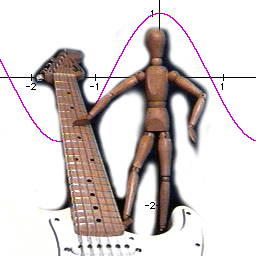
|
|
the bow is the antinode
|
|
Hold arms still in a sine shape, one arm curves up,
the other curves down.
Kind of looks Egyptian doesn't it?
Do arms in a cosine shape, both arms flap at same
time.
Are you a bird?
Which is symmetric about the head?
Do mummies fly?
The distance from hand to hand is called the WAVELENGTH.
Flatten arms out, at the flute hand distance, that
is quiet.
Bend arms more, at the flute hand distance, that
is loud.
I want my mummy!
Now flap the arms in a smooth and perfect wave.
How often the arms flap, is called the FREQUENCY.
Spread arms out, that is a cello.
Bring arms closer, that is a flute.
A flute makes almost a perfect sine wave.
Bring them in really tight, that is a violin.
The idea of FREQUENCY is closely related to the idea
of spinning around.
When the dancer spins SLOWLY, that is a cello
wave. (cellist plays low note)
Spin with the arms in first, MEDIUM , that is a
flute wave. (flutist plays middle C)
Spin with the arms close in FAST,
that is a violin wave. (violinist plays highest note)
I feel dizzy!
Both sound AND LIGHT are WAVES
Spinning SLOWLY is what red light does. (dancer
lit with red spot)
Spinning MEDIUM is what green light does. (dancer
lit with green spot )
Spinning RAPIDLY is what blue light does. (dancer
lit with blue spot)
And if you fall down that is an X-Ray! (two men
appear with a stretcher!)
The FREQUENCY times WAVELENGTH is the how fast the
standing wave would travel if we
let it go to find ITS mummy.
Or if you prefer, in unison please:
|
Dancer
|
Narrator
|
Musician(s)
|
Light
|
|
Spins SLOWLY
with the arms way out.
|
Spinning SLOWLY is what
red light does...
|
cellist plays low note,
bowing slowly
|
dancer lit with red spot
|
|
Spins MEDIUM
with the arms in first.
|
Spinning MEDIUM is what
green light does...
|
flutist plays middle C,
blowing lightly
|
dancer lit with green spot
|
|
Spins RAPIDLY
with the arms over head.
|
Spinning RAPIDLY is what
green light does...
|
violinist plays highest note, bowing quickly
|
dancer lit with blue spot
|
|
Is DIZZY
and falls down!
|
And if you fall down,
THAT is an X-Ray!
|
stare in horror
as two medics appear with a stretcher!
|
spinning ambulance
light
|
Questions:
Which takes less power to be heard, a low note or
a high note?
Which travels faster, sound or light?
Does sound travel faster or slower in water?
Answers:
Low notes require much more power than high notes.
Light travels
186,000 miles per second.
Sound travels about 1000 feet per second in
air, give or take.
Sound travels nearly 5000 feet per second in water.
Reality Checks:
Beepers and telephones use high notes to get our
attention.
We see the lightning before we hear the thunder.
Whales can communicate vast distances in the ocean.
Extra Credit
Formula:
c = f L
- the speed of a wave
Means
c = speed
- how fast the wave moves away from the source
f = frequency
- how rapidly the wave vibrates
L = wavelength - how long
or short the wave is